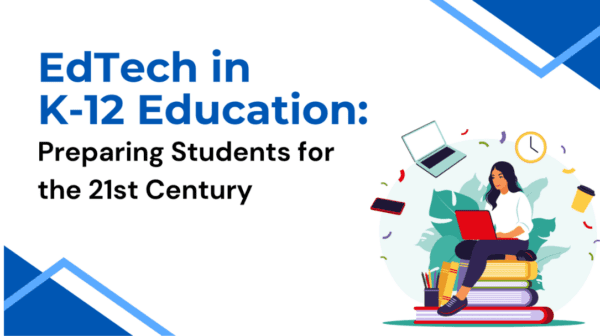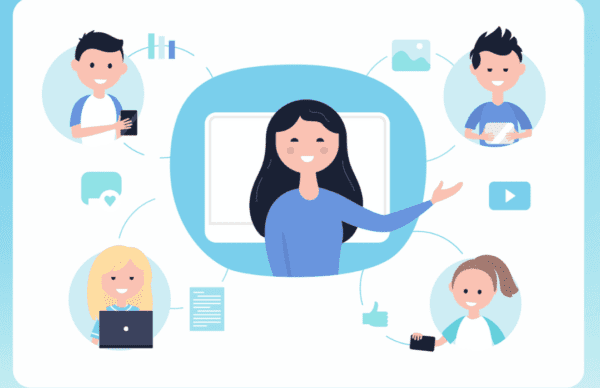If you’re a teacher, administrator, or parent of a K-12 student, you’re likely familiar with the term “edtech.” Edtech refers to the use of technology in education, and it has become increasingly popular in recent years. With the rise of digital learning tools, online classes, and interactive educational software, tech has transformed how students learn and teachers teach.
Edtech methods have proven particularly useful during the COVID-19 pandemic, forcing many schools to switch to remote learning. According to EY, about 60% of educators using digital planning tools adopted them during the pandemic, and daily usage of digital instructional materials has jumped from 28% before the pandemic to 54% during the pandemic. As a result, edtech has become an essential part of K-12 education, allowing students to continue learning even when they cannot attend school in person.
However, edtech is not without its challenges. Some critics argue that it can be expensive, difficult to implement, and may not constantly improve student outcomes. As such, it’s essential to carefully evaluate edtech tools and methods to ensure they align with your educational goals and objectives. This article explores some of the most effective edtech methods for K12 education and discusses how to implement them successfully.

Foundations of EdTech in K-12 Education
As technology continues to evolve, its integration into K-12 education has become increasingly important. EdTech, or educational technology, has the potential to enhance learning experiences and provide students with more opportunities to succeed. In this section, we will explore the foundations of EdTech in K-12 education, including the K-12 curriculum and digital education, approaches to learning, and cybersecurity in education.
K-12 Curriculum and Digital Education
The K-12 curriculum is constantly evolving, and digital education has become an integral part of it. Digital education can include anything from online classes and virtual field trips to interactive learning tools and educational apps. Integrating digital education into the K-12 curriculum has provided students with more learning opportunities. It has made education more accessible to students who may not have had access to traditional learning methods.
Approaches to Learning
EdTech has also provided educators with new approaches to teaching and learning. For example, adaptive learning technologies can personalize individual students’ learning experiences, while gamification can make learning more engaging and fun. EdTech tools like online discussion forums and virtual study groups can provide students with a collaborative learning environment beyond the classroom.
Cybersecurity in Education
As with any technology, cybersecurity is essential for EdTech in K-12 education. The Cybersecurity and Infrastructure Security Agency (CISA), the National Cyber Security Alliance, and the FBI all offer resources and guidance on how to keep sensitive information secure in an educational setting. It is essential for educators and students to be aware of the risks associated with using technology in the classroom and to take steps to protect themselves and their data. This includes using secure websites with HTTPS protocols, avoiding sharing sensitive information, and being aware of potential phishing scams.
Overall, EdTech has the potential to revolutionize the way we approach K-12 education. By understanding the foundations of EdTech in K-12 education, including the K-12 curriculum and digital education, to learning and cybersecurity in education, educators and students can make the most of the opportunities technology provides.

Instructional Methods and Strategies
As an educator, you must be familiar with different instructional methods and strategies that can help students learn better. This section will discuss some of the most effective techniques and strategies you can use in your K-12 classroom.
Direct and Indirect Instruction
Direct instruction is a teacher-centred approach that explicitly teaches skills and concepts through lectures, demonstrations, and guided practice. This method is particularly effective for teaching foundational skills such as reading, writing, and math.
Indirect instruction, on the other hand, is a student-centred approach that involves discovery learning and problem-solving. This method is particularly effective for teaching higher-order thinking skills such as critical thinking and problem-solving.
Differentiated Instruction and Spiral Progression
Differentiated instruction is an approach that involves tailoring instruction to meet students’ individual needs. This method is particularly effective for teaching students with diverse learning needs, including students with disabilities and English language learners.
Spiral progression is an approach that involves revisiting previously learned concepts and skills in a way that builds upon prior knowledge. This method is particularly effective for teaching complex concepts and skills that require a deep understanding of foundational concepts.
Collaborative Learning and Engagement
Collaborative learning is an approach that involves students working together in groups to achieve a common goal. This method promotes social skills and teamwork and teaches students how to work effectively with others.
Engagement is a critical component of effective instruction. Engaged students are more motivated and more likely to learn and retain information. Some effective strategies for promoting engagement include using technology, incorporating hands-on activities, and providing opportunities for student choice and autonomy.

Incorporating various instructional methods and strategies can help you create a dynamic and engaging classroom environment that meets the diverse needs of your students. By using direct and indirect instruction, differentiated instruction and spiral progression, and collaborative learning and engagement, you can help your students achieve their full potential.
Technology Integration and Management
Integrating technology into your K-12 classroom can be daunting as an educator. However, with the right tools and strategies, you can effectively manage your resources and leverage edtech platforms to enhance student learning. This section will explore some critical considerations for integrating technology in your classroom.
Leveraging EdTech Platforms
EdTech platforms such as Google Workspace and Microsoft 365 offer a range of tools and resources to support teaching and learning. These platforms can create and manage assignments, collaborate with students, and provide feedback on student work.
One of the key benefits of using these platforms is that they allow for seamless integration with other tools and applications. For example, you can use Google Classroom to create and manage assignments and then use Google Docs to provide feedback on student work. Similarly, you can use Microsoft Teams to collaborate with students and use OneNote to organize and manage your resources.
Effective Resource Management
Managing your resources effectively is critical to successful technology integration. This includes managing your hardware, software, and digital resources, such as lesson plans and student work.
One helpful tool for managing your digital resources is ManagedMethods. This platform allows you to monitor and manage your cloud applications, ensuring that your data remains secure and your resources are used effectively.

Professional Development for Educators
Finally, investing in professional development for yourself and your colleagues is essential. This can include attending workshops and conferences, participating in online courses, and collaborating with other educators.
By investing in professional development, you can stay up-to-date with the latest trends and best practices in edtech integration. This will help you to manage your resources effectively and leverage edtech platforms to enhance student learning.
In conclusion, integrating technology into your K-12 classroom can be a challenging but rewarding experience. By leveraging edtech platforms, effectively managing your resources, and investing in professional development, you can enhance student learning and prepare your students for success in the digital age.
Challenges and Solutions in EdTech
As with any technology, EdTech faces its own set of challenges. However, with proper planning and implementation, these challenges can be mitigated or even eliminated. Here are some of the most pressing challenges in EdTech and how to address them.
Preventing and Responding to Cyber Threats
One of the most significant challenges in EdTech is cybersecurity. As more and more schools adopt technology in the classroom, there is an increased risk of cyber threats such as ransomware and phishing attacks. To prevent these attacks, it’s crucial to have a comprehensive cybersecurity plan in place. This plan should include regular software updates, strong passwords, and user training on identifying and responding to cyber threats.
In the event of a cyber attack, it’s essential to have a response plan in place. This plan should include steps for containing the attack, restoring data, and communicating with stakeholders. By having a solid cybersecurity plan and response plan in place, you can minimize the impact of cyber threats on your school’s technology infrastructure.
Addressing Cheating and Academic Integrity
Another challenge in EdTech is addressing cheating and maintaining academic integrity. With the increased use of technology in the classroom, students have more potential to cheat. To address this challenge, it’s essential to have clear policies and procedures outlining what constitutes cheating and the consequences for violating these policies.

In addition to policies and procedures, fostering a culture of academic integrity is crucial. This can be achieved by promoting critical thinking and problem-solving skills, encouraging collaboration, and emphasizing the importance of honesty and integrity.
Fostering Creative and Critical Thinking
Finally, EdTech can also present challenges in fostering creative and critical thinking skills in students. While technology can be a powerful tool for learning, it can also be a crutch that hinders critical thinking and problem-solving skills. To address this challenge, it’s essential to use technology to encourage creativity and critical thinking.
One way to accomplish this is by using technology to support project-based learning. This approach allows students to work collaboratively on real-world problems, encouraging them to think creatively and critically. Technology facilitating discussions and debates can also help foster critical thinking skills.
In conclusion, EdTech presents various challenges, from cybersecurity threats to maintaining academic integrity and fostering creative and critical thinking skills. However, with proper planning and implementation, these challenges can be overcome, and technology can be a powerful tool for enhancing K-12 education.
Future Perspectives in K-12 EdTech
As technology continues to advance, the future of K-12 education will be shaped by emerging trends in online and hybrid learning, as well as the role of EdTech in developing future skills.
Emerging Trends in Online and Hybrid Learning
Due to the pandemic, distance learning has become a necessary tool in K-12 education. As schools begin to reopen, hybrid learning is becoming more popular. Hybrid learning combines online and in-person learning, allowing students to learn at their own pace while still receiving the support they need from teachers.
One of the benefits of hybrid learning is that it allows students to take more control of their learning experience. Students can work on their own time with more flexible schedules, increasing productivity and engagement. Additionally, hybrid learning can provide students with a more personalized learning experience, as they can work at their own pace and receive individualized attention from teachers.

The Role of EdTech in Developing Future Skills
EdTech is increasingly essential in developing future skills, such as critical thinking, problem-solving, and creativity. Using technology in the classroom, students can develop these skills more engagingly and interactively.
One approach to using EdTech in the classroom is to use gamification. Gamification involves using game-like elements, such as points, badges, and leaderboards, to motivate students and make learning fun. This approach can help students develop grit and perseverance in facing challenges.
Another approach is to use project-based learning. Project-based learning involves giving students a task to complete, such as creating a video or designing a website. This approach can help students develop the skills they need to succeed in the 21st century, such as collaboration, communication, and critical thinking.
In conclusion, the future of K-12 education will be shaped by emerging trends in online and hybrid learning, as well as the role of EdTech in developing future skills. Using technology in the classroom allows students to develop the skills they need to succeed in the 21st century.
